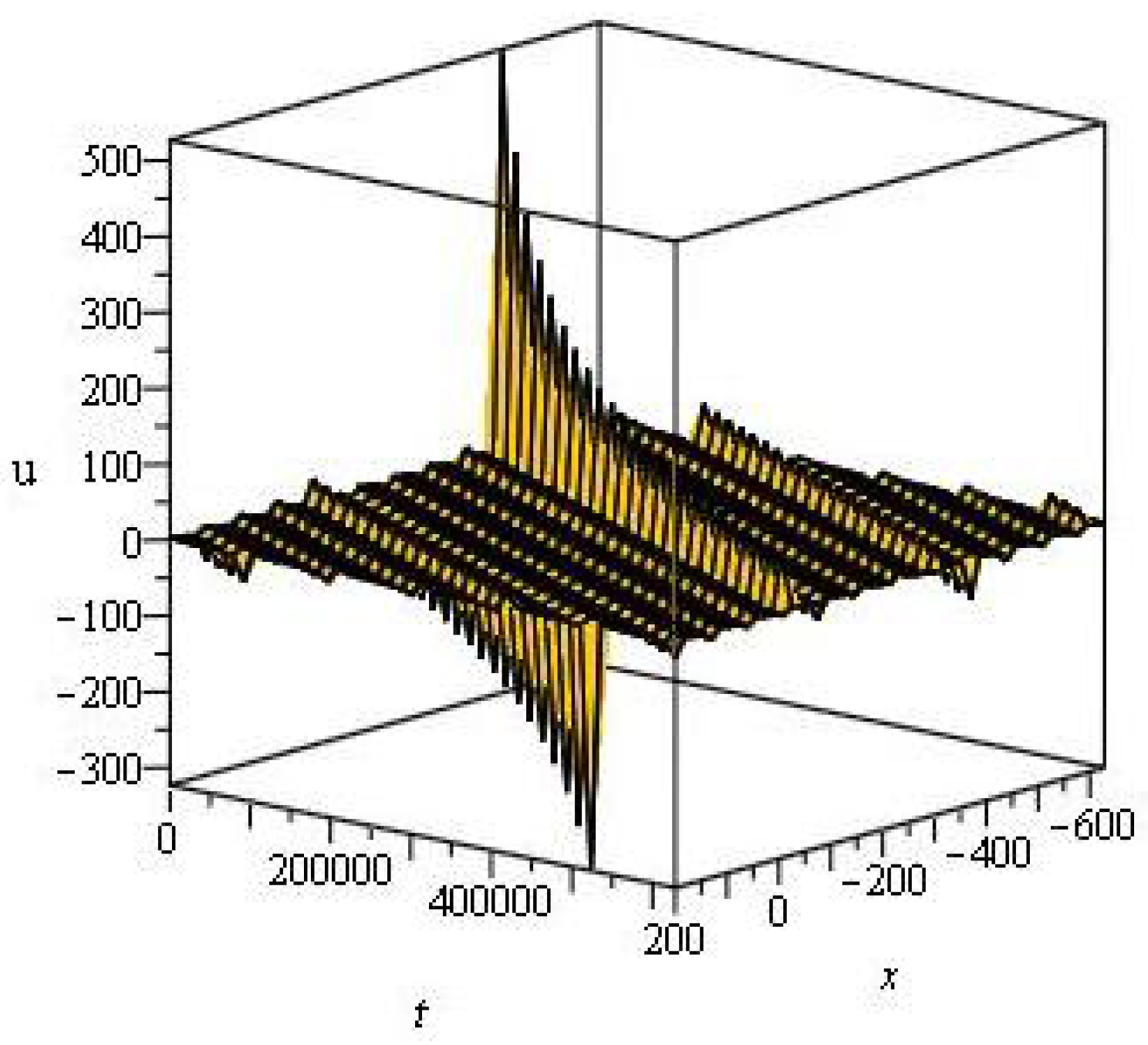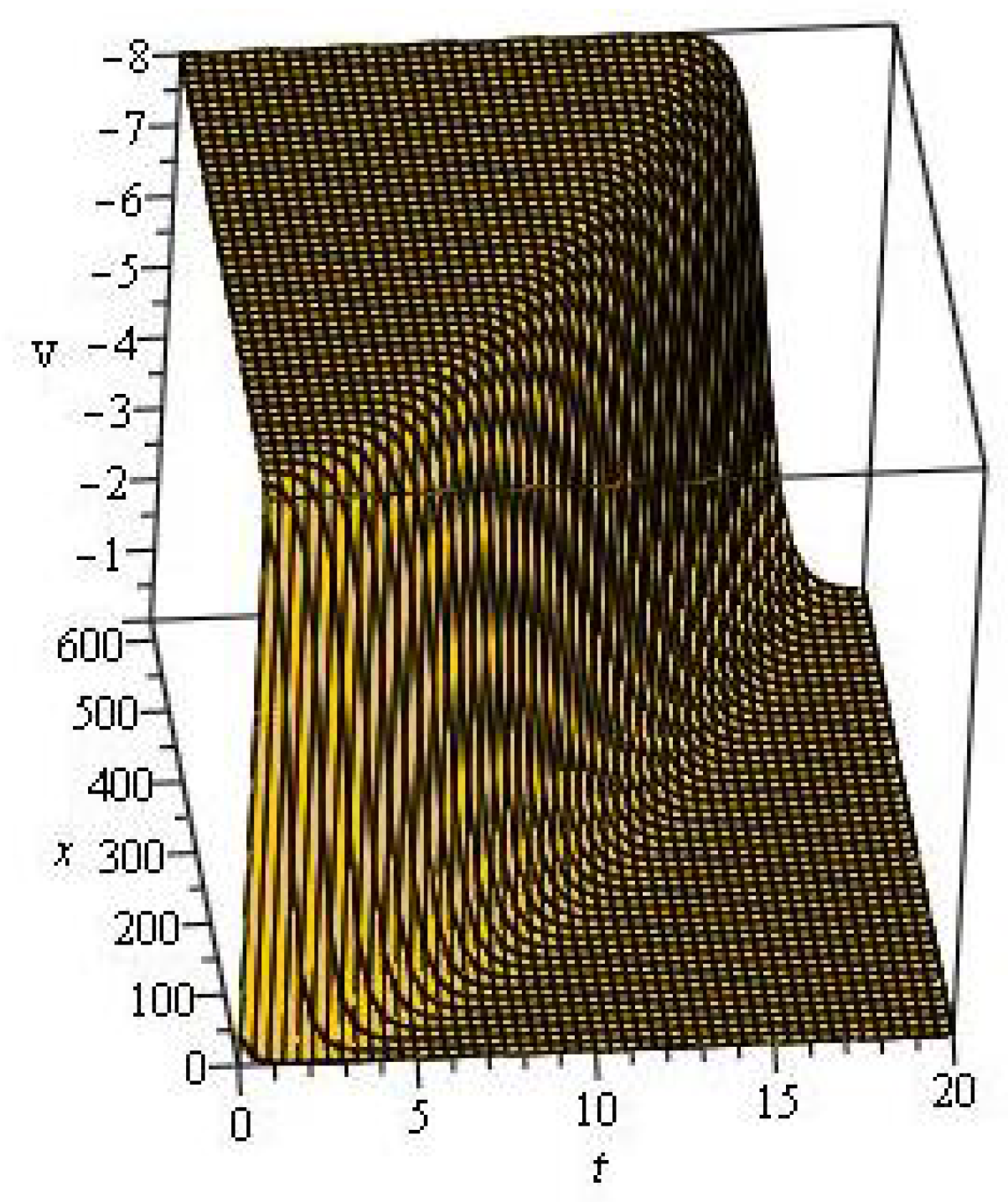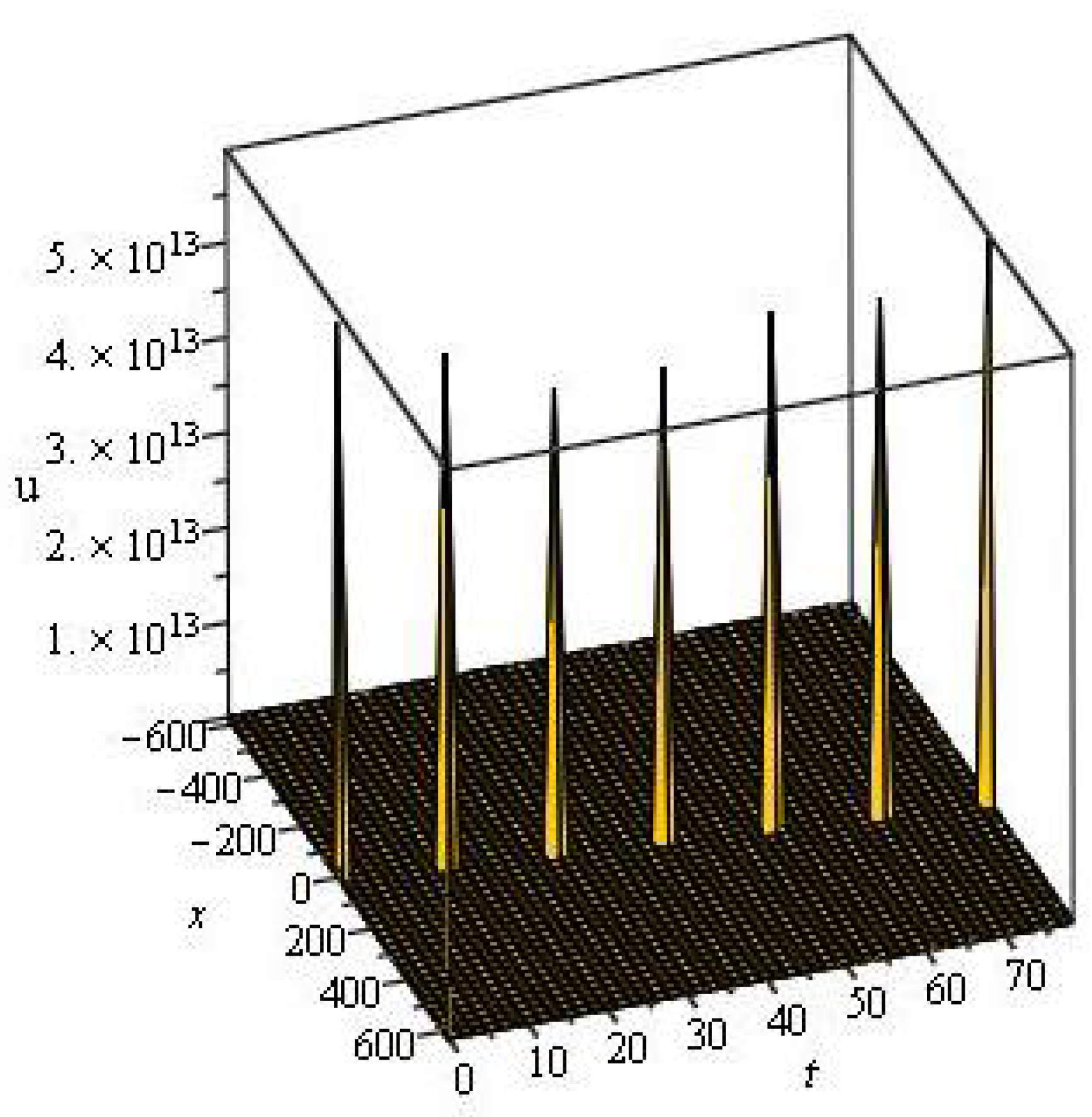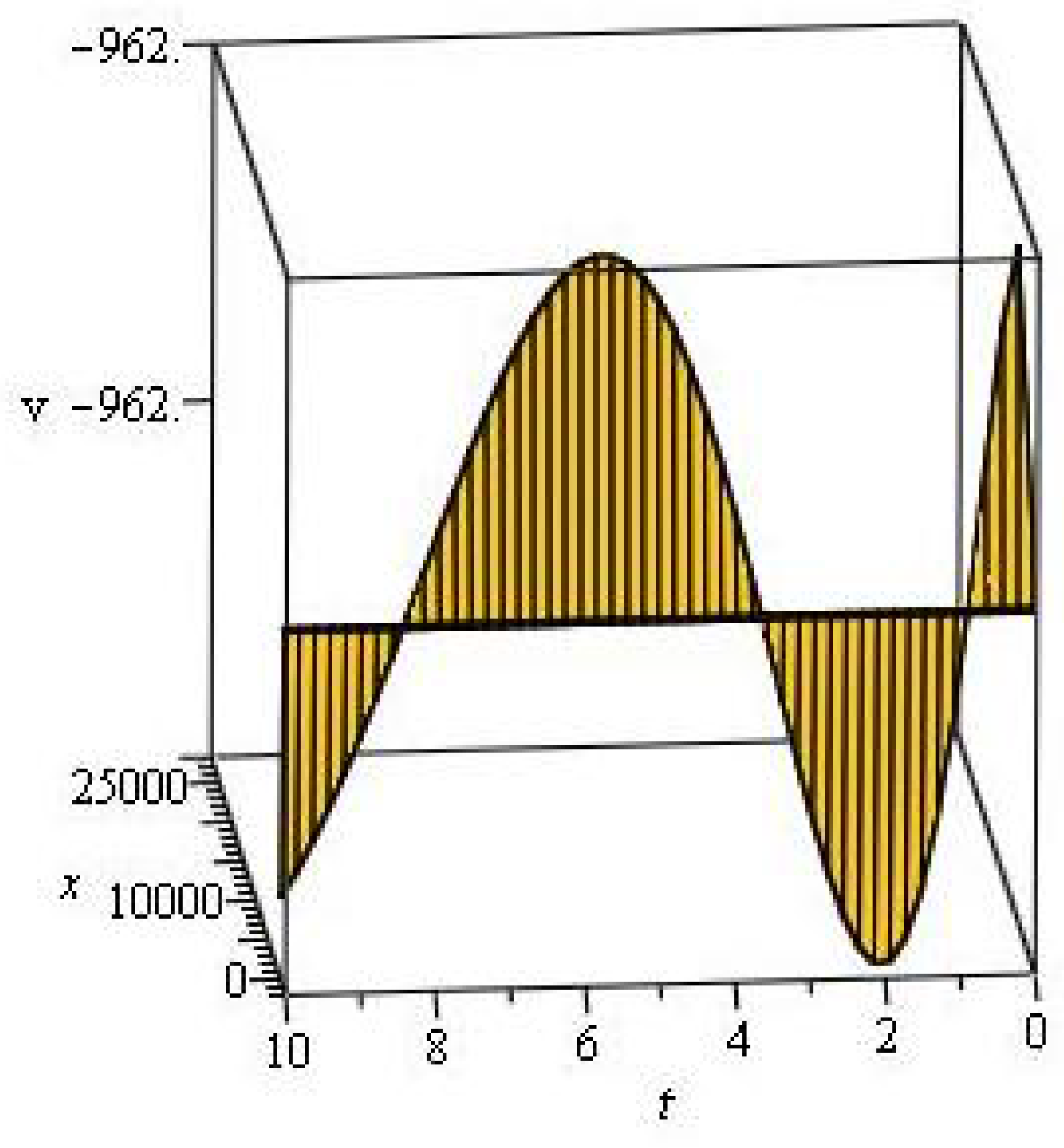Investigating Symmetric Soliton Solutions for the Fractional Coupled Konno–Onno System Using Improved Versions of a Novel Analytical Technique
Abstract
:1. Introduction
2. Method and Materials
- Firstly, a variable transformation of the form , , (where can be described in different ways) is carried out to transform (6) into a NODE of the form:where derivatives of U in (7) are with regard to . Equation (7) can be integrated one or more times occasionally to acquire integration’s constant.
- According to the version of EDAM, we assume one of the following solution for (7):
- 1.
- mEDAM suggests the following series form solution:
- 2.
- r + mEDAM suggests the following series form solution:where are unknown constants to be determined later, and is the general solution of the following ODE:where and and C are in variables.
- Taking the homogeneous balance between the highest order derivative and the greatest nonlinear term in (7) gives the positive integer n presented in (8) and (9).
- After that, we put (8) or (9) into (7) or in equation generated by integrating (7) and then we collect all the terms of of the same order which turn out an expression in . By the principle of comparing the coefficient, we equate all the coefficients in the expression to zero, which yields a system of algebraic equations in and other parameters.
- We employ Maple software to solve this system of algebraic equations.
- The symmetric soliton solutions to (6) are then investigated by calculating the unknown coefficients and other parameters and putting them in (8) or (9) along with the (general solution of (10)). By this general solution of (10), the following families of soliton solutions can be generated:
- Family. 1: When then we obtain the subsequent family of soliton solutions:and
- Family. 2: When then we obtain the subsequent family of soliton solutions:and
- Family. 3: When and then we obtain the subsequent family of soliton solutions:and
- Family. 4: When and then we obtain the subsequent family of soliton solutions:and
- Family. 5: When and then we obtain the subsequent family of soliton solutions:and
- Family. 6: When and then we obtain the subsequent family of soliton solutions:and
- Family. 7: When then we obtain the subsequent family of soliton solutions:
- Family. 8: When , and then we obtain the subsequent family of soliton solutions:
- Family. 9: When then we obtain the subsequent family of soliton solutions:
- Family. 10: When then we obtain the subsequent family of soliton solutions:
- Family. 11: When , and then we obtain the subsequent family of soliton solutions:and
- Family. 12: When , and we obtain the subsequent family of soliton solutions:
3. Results
3.1. Implementation of mEDAM
- Case. 1
- Case. 2
- Family. 1: When then (11), (13) and corresponding general solutions of (10) imply the following family of symmetric soliton solutions:and
- Family. 2: When then (11), (13) and corresponding general solutions of (10) imply the following family of symmetric soliton solutions:and
- Family. 3: When and then (11), (13) and corresponding general solutions of (10) imply the following family of symmetric soliton solutions:and
- Family. 4: When and then (11), (13) and corresponding general solutions of (10) imply the following family of symmetric soliton solutions:and
- Family. 5: When and then (11), (13) and corresponding general solutions of (10) imply the following family of symmetric soliton solutions:and
- Family. 6: When and then (11), (13) and corresponding general solutions of (10) imply the following family of symmetric soliton solutions:and
- Family. 7: When , and then (11), (13) and corresponding general solutions of (10) imply the following family of symmetric soliton solutions:where .
- Family. 8: When then (11), (13) and corresponding general solutions of (10) imply the following family of symmetric soliton solutions:and
- Family. 9: When then (11), (13) and corresponding general solutions of (10) imply the following family of symmetric soliton solutions:and
- Family. 10: When and then (11), (13) and corresponding general solutions of (10) imply the following family of symmetric soliton solutions:and
- Family. 11: When and then (11), (13) and corresponding general solutions of (10) imply the following family of symmetric soliton solutions:and
- Family. 12: When and then (11), (13) and corresponding general solutions of (10) imply the following family of symmetric soliton solutions:and
- Family. 13: When and then (11), (13) and corresponding general solutions of (10) imply the following family of symmetric soliton solutions:and
- Family. 14: When , and then (11), (13) and corresponding general solutions of (10) imply the following family of symmetric soliton solutions:and
- Family. 15: When , and then (11), (13) and corresponding general solutions of (10) imply the following family of symmetric soliton solutions:where .
3.2. Implementation of r + mEDAM
- Case. 1
- Case. 2
- Family. 16: When then (11), (13) and corresponding general solutions of (10) imply the following family of symmetric soliton solutions:and
- Family. 17: When then (11), (13) and corresponding general solutions of (10) imply the following family of symmetric soliton solutions:and
- Family. 18: When and then (11), (13) and corresponding general solutions of (10) imply the following family of symmetric soliton solutions:and
- Family. 19: When and then (11), (13) and corresponding general solutions of (10) imply the following family of symmetric soliton solutions:and
- Family. 20: When and then (11), (13) and corresponding general solutions of (10) imply the following family of symmetric soliton solutions:and
- Family. 21: When and then Equations (19) and (10) imply the following solitary wave solutions:and
- Family. 22: When , and then (11), (13) and corresponding general solutions of (10) imply the following family of symmetric soliton solutions:
- Family. 23: When , and then (11), (13) and corresponding general solutions of (10) imply the following family of symmetric soliton solutions:and
- Family. 24: When , and then (11), (13) and corresponding general solutions of (10) imply the following family of symmetric soliton solutions:where .
- Family. 25: When then (11), (13) and corresponding general solutions of (10) imply the following family of symmetric soliton solutions:and
- Family. 26: When then (11), (13) and corresponding general solutions of (10) imply the following family of symmetric soliton solutions:and
- Family. 27: When and then (11), (13) and corresponding general solutions of (10) imply the following family of symmetric soliton solutions:and
- Family. 28: When and then (11), (13) and corresponding general solutions of (10) imply the following family of symmetric soliton solutions:and
- Family. 29: When and then (11), (13) and corresponding general solutions of (10) imply the following family of symmetric soliton solutions:and
- Family. 30: When and then (11), (13) and corresponding general solutions of (10) imply the following family of symmetric soliton solutions:and
- Family. 31: When , and then (11), (13) and corresponding general solutions of (10) imply the following family of symmetric soliton solutions:and
- Family. 32: When , and then (11), (13) and corresponding general solutions of (10) imply the following family of symmetric soliton solutions:where .
4. Discussion and Graphs
5. Conclusions
Author Contributions
Funding
Data Availability Statement
Acknowledgments
Conflicts of Interest
References
- Abro, K.A.; Atangana, A. Dual fractional modeling of rate type fluid through nonlocal differentiation. Numer. Methods Part. Differ. Equ. 2022, 38, 390–405. [Google Scholar]
- Shah, N.A.; Alyousef, H.A.; El-Tantawy, S.A.; Chung, J.D. Analytical investigation of fractional-order Korteweg-De-Vries-type equations under Atangana-Baleanu-Caputo operator: Modeling nonlinear waves in a plasma and fluid. Symmetry 2022, 14, 739. [Google Scholar] [CrossRef]
- Tarasov, V.E.; Zaslavsky, G.M. Fractional dynamics of systems with long-range interaction. Commun. Nonlinear Sci. Numer. Simul. 2006, 11, 885–898. [Google Scholar] [CrossRef] [Green Version]
- Su, N. Random fractional partial differential equations and solutions for water movement in soils: Theory and applications. Hydrol. Process. 2023, 37, e14844. [Google Scholar] [CrossRef]
- Che, J.; Guan, Q.; Wang, X. Image denoising based on adaptive fractional partial differential equations. In Proceedings of the 2013 6th International Congress on Image and Signal Processing (CISP), Hangzhou, China, 16–18 December 2013; IEEE: Piscataway, NJ, USA, 2013; Volume 1, pp. 288–292. [Google Scholar]
- Hamed, Y.S.; Abualnaja, K.M.; Chung, J.D.; Khan, A. A comparative analysis of fractional-order kaup-kupershmidt equation within different operators. Symmetry 2022, 14, 986. [Google Scholar]
- Shah, N.A.; Wakif, A.; Yook, S.J.; Salah, B.; Mahsud, Y.; Hussain, K. Effects of fractional derivative and heat source/sink on MHD free convection flow of nanofluids in a vertical cylinder: A generalized Fourier’s law model. Case Stud. Therm. Eng. 2021, 28, 101518. [Google Scholar] [CrossRef]
- Alderremy, A.A.; Aly, S.; Fayyaz, R.; Khan, A.; Shah, R.; Wyal, N. The analysis of fractional-order nonlinear systems of third order KdV and Burgers equations via a novel transform. Complexity 2022, 2022, 4935809. [Google Scholar] [CrossRef]
- Singh, J.; Kumar, D.; Kılıçman, A. Numerical solutions of nonlinear fractional partial differential equations arising in spatial diffusion of biological populations. Abstr. Appl. Anal. 2014, 2014, 535793. [Google Scholar] [CrossRef] [Green Version]
- Kbiri, A.M.; Nonlaopon, K.; Zidan, A.M.; Khan, A. Analytical investigation of fractional-order Cahn-Hilliard and gardner equations using two novel techniques. Mathematics 2022, 10, 1643. [Google Scholar] [CrossRef]
- Wang, Z.; Ahmadi, A.; Tian, H.; Jafari, S.; Chen, G. Lower-dimensional simple chaotic systems with spectacular features. Chaos Solitons Fractals 2023, 169, 113299. [Google Scholar] [CrossRef]
- Jin, H.Y.; Wang, Z.A. Global stabilization of the full attraction-repulsion Keller-Segel system. Discret. Contin. Dyn.-Syst. 2020, 40, 3509–3527. [Google Scholar] [CrossRef] [Green Version]
- Zhang, Y. A finite difference method for fractional partial differential equation. Appl. Math. Comput. 2009, 215, 524–529. [Google Scholar] [CrossRef]
- Ford, N.J.; Xiao, J.; Yan, Y. A finite element method for time fractional partial differential equations. Fract. Calc. Appl. Anal. 2011, 14, 454–474. [Google Scholar] [CrossRef] [Green Version]
- Elagan, S.K.; Sayed, M.; Higazy, M. An analytical study on fractional partial differential equations by Laplace transform operator method. Int. J. Appl. Eng. Res. 2018, 13, 545–549. [Google Scholar]
- Mahor, T.C.; Mishra, R.; Jain, R. Analytical solutions of linear fractional partial differential equations using fractional Fourier transform. J. Comput. Appl. Math. 2021, 385, 113202. [Google Scholar] [CrossRef]
- Jin, H.Y.; Wang, Z. Asymptotic dynamics of the one-dimensional attraction-repulsion Keller-Segel model. Math. Methods Appl. Sci. 2015, 38, 444–457. [Google Scholar] [CrossRef]
- Lyu, W.; Wang, Z. Global classical solutions for a class of reaction-diffusion system with density-suppressed motility. Electron. Res. Arch. 2022, 30, 995–1015. [Google Scholar] [CrossRef]
- Zhang, J.; Wang, X.; Zhou, L.; Liu, G.; Adroja, D.T.; da Silva, I.; Demmel, F.; Khalyavin, D.; Sannigrahi, J.; Nair, H.S.; et al. A Ferrotoroidic Candidate with Well-Separated Spin Chains. Adv. Mater. 2022, 34, e2106728. [Google Scholar] [CrossRef]
- Chung, K.L.; Tian, H.; Wang, S.; Feng, B.; Lai, G. Miniaturization of microwave planar circuits using composite microstrip/coplanar-waveguide transmission lines. Alex. Eng. J. 2022, 61, 8933–8942. [Google Scholar] [CrossRef]
- Song, J.; Mingotti, A.; Zhang, J.; Peretto, L.; Wen, H. Fast iterative-interpolated DFT phasor estimator considering out-of-band interference. IEEE Trans. Instrum. Meas. 2022, 71, 1–14. [Google Scholar] [CrossRef]
- Dai, Z.; Xie, J.; Jiang, M. A coupled peridynamics-smoothed particle hydrodynamics model for fracture analysis of fluid-structure interactions. Ocean Eng. 2023, 279, 114582. [Google Scholar] [CrossRef]
- Khan, H.; Baleanu, D.; Kumam, P.; Al-Zaidy, J.F. Families of travelling waves solutions for fractional-order extended shallow water wave equations, using an innovative analytical method. IEEE Access 2019, 7, 107523–107532. [Google Scholar] [CrossRef]
- Momani, S.; Odibat, Z. Homotopy perturbation method for nonlinear partial differential equations of fractional order. Phys. Lett. A 2007, 365, 345–350. [Google Scholar] [CrossRef]
- Odibat, Z.; Momani, S. The variational iteration method: An efficient scheme for handling fractional partial differential equations in fluid mechanics. Comput. Math. Appl. 2009, 58, 2199–2208. [Google Scholar] [CrossRef] [Green Version]
- Guner, O.; Bekir, A. The Exp-function method for solving nonlinear space–time fractional differential equations in mathematical physics. J. Assoc. Arab. Univ. Basic Appl. Sci. 2017, 24, 277–282. [Google Scholar] [CrossRef] [Green Version]
- Jabbari, A.; Kheiri, H.; Bekir, A. Exact solutions of the coupled Higgs equation and the Maccari system using He’s semi-inverse method and (G’/G)-expansion method. Comput. Math. Appl. 2011, 62, 2177–2186. [Google Scholar] [CrossRef] [Green Version]
- Manafian, J.; Foroutan, M. Application of tan(ϕ(ξ)/2)-expansion method for the time-fractional Kuramoto-Sivashinsky equation. Opt. Quantum Electron. 2017, 49, 1–18. [Google Scholar] [CrossRef]
- Younis, M.; Iftikhar, M. Computational examples of a class of fractional order nonlinear evolution equations using modified extended direct algebraic method. J. Comput. Methods Sci. Eng. 2015, 15, 359–365. [Google Scholar] [CrossRef]
- Zhang, J.; Xie, J.; Shi, W.; Huo, Y.; Ren, Z.; He, D. Resonance and bifurcation of fractional quintic Mathieu-Duffing system. Chaos: Interdiscip. J. Nonlinear Sci. 2023, 33, 23131. [Google Scholar] [CrossRef]
- Li, X.; Dong, Z.Q.; Wang, L.P.; Niu, X.D.; Yamaguchi, H.; Li, D.C.; Yu, P. A magnetic field coupling fractional step lattice Boltzmann model for the complex interfacial behavior in magnetic multiphase flows. Appl. Math. Model. 2023, 117, 219–250. [Google Scholar] [CrossRef]
- Guo, C.; Hu, J. Fixed-Time Stabilization of High-Order Uncertain Nonlinear Systems: Output Feedback Control Design and Settling Time Analysis. J. Syst. Sci. Complex. 2023, 1–22. [Google Scholar] [CrossRef]
- Liu, X.; He, J.; Liu, M.; Yin, Z.; Yin, L.; Zheng, W. A Scenario-Generic Neural Machine Translation Data Augmentation Method. Electronics 2023, 12, 2320. [Google Scholar] [CrossRef]
- Lu, S.; Liu, M.; Yin, L.; Yin, Z.; Liu, X.; Zheng, W. The multi-modal fusion in visual question answering: A review of attention mechanisms. Peerj Comput. Sci. 2023, 9, e1400. [Google Scholar] [CrossRef]
- Lu, S.; Ding, Y.; Liu, M.; Yin, Z.; Yin, L.; Zheng, W. Multiscale Feature Extraction and Fusion of Image and Text in VQA. Int. J. Comput. Intell. Syst. 2023, 16, 54. [Google Scholar] [CrossRef]
- Konno, K.; Oono, H. New coupled integrable dispersionless equations. J. Phys. Soc. Jpn. 1994, 63, 377–378. [Google Scholar] [CrossRef]
- Mirhosseini-Alizamini, S.M.; Rezazadeh, H.; Srinivasa, K.; Bekir, A. New closed form solutions of the new coupled Konno–Oono equation using the new extended direct algebraic method. Pramana 2020, 94, 1–12. [Google Scholar] [CrossRef]
- Elbrolosy, M.E.; Elmandouh, A.A. Dynamical behaviour of conformable time-fractional coupled Konno–Oono equation in magnetic field. Math. Probl. Eng. 2022, 2022, 3157217. [Google Scholar] [CrossRef]
- Koçak, Z.F.; Bulut, H.; Koc, D.A.; Baskonus, H.M. Prototype traveling wave solutions of new coupled Konno–Oono equation. Optik 2016, 127, 10786–10794. [Google Scholar] [CrossRef]
- Bashar, M.A.; Mondal, G.; Khan, K.; Bekir, A. Traveling wave solutions of new coupled Konno–Oono equation. New Trends Math. Sci. 2016, 4, 296–303. [Google Scholar] [CrossRef]
- Naeem, M.; Yasmin, H.; Shah, R.; Shah, N.A.; Chung, J.D. A Comparative Study of Fractional Partial Differential Equations with the Help of Yang Transform. Symmetry 2023, 15, 146. [Google Scholar] [CrossRef]
- Rehman, H.U.; Ullah, N.; Imran, M.A. Optical solitons of Biswas-Arshed equation in birefringent fibers using extended direct algebraic method. Optik 2021, 226, 165378. [Google Scholar] [CrossRef]




Disclaimer/Publisher’s Note: The statements, opinions and data contained in all publications are solely those of the individual author(s) and contributor(s) and not of MDPI and/or the editor(s). MDPI and/or the editor(s) disclaim responsibility for any injury to people or property resulting from any ideas, methods, instructions or products referred to in the content. |
© 2023 by the authors. Licensee MDPI, Basel, Switzerland. This article is an open access article distributed under the terms and conditions of the Creative Commons Attribution (CC BY) license (https://creativecommons.org/licenses/by/4.0/).
Share and Cite
Yasmin, H.; Aljahdaly, N.H.; Saeed, A.M.; Shah, R. Investigating Symmetric Soliton Solutions for the Fractional Coupled Konno–Onno System Using Improved Versions of a Novel Analytical Technique. Mathematics 2023, 11, 2686. https://doi.org/10.3390/math11122686
Yasmin H, Aljahdaly NH, Saeed AM, Shah R. Investigating Symmetric Soliton Solutions for the Fractional Coupled Konno–Onno System Using Improved Versions of a Novel Analytical Technique. Mathematics. 2023; 11(12):2686. https://doi.org/10.3390/math11122686
Chicago/Turabian StyleYasmin, Humaira, Noufe H. Aljahdaly, Abdulkafi Mohammed Saeed, and Rasool Shah. 2023. "Investigating Symmetric Soliton Solutions for the Fractional Coupled Konno–Onno System Using Improved Versions of a Novel Analytical Technique" Mathematics 11, no. 12: 2686. https://doi.org/10.3390/math11122686





